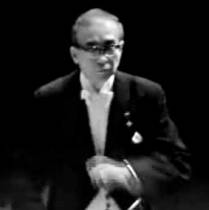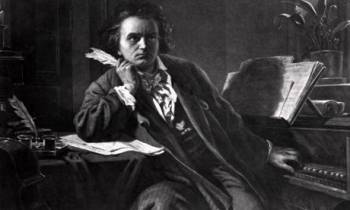
Hidemaro Konoye (18 November 1898—2 June 1973)
Hidemaro Konoye was a conductor and composer of classical music in Shōwa period Japan. He was the brother of pre-war Japanese Prime Minister Fumimaro Konoe. Konoye was born in Kōjimachi, Tokyo as the younger son of Prince Konoe Atsumaro, scion of one of the Five regent houses of the Fujiwara clan. The Konoe clan traditionally provided gagaku musicians to the Imperial Household, and Hidemaro chose to follow the family’s musical tradition, whereas his older brother Fumimaro went into politics. Konoye attended the Gakushuin Peers School, where he became a close friend of Takashi Inukai. In 1913, he entered the Tokyo University of the Arts, where he specialized in the violin. In 1915, he went to study briefly in Germany to study musical composition, and became a pupil of Kosaku Yamada on his return to Japan. His debut as a conductor was in 1920, with an amateur orchestra led by Toukichi Setoguchi. Konoye returned to Europe for further studies in 1923 in Paris under Vincent d'Indy and Berlin under Franz Schreker. He also studied conducting under Erich Kleiber, and Karl Muck. In 1924, he conducted at the Berlin Philharmonic, and returned to Japan in the fall of the same year. Konoye co-founded the Japan Symphonic Association in 1925, and the following year became conductor of the orchestra. Konoe later founded the New Symphony Orchestra of Tokyo (the present day NHK Symphony Orchestra), and helped mold the orchestra over a 10 year period into an ensemble that was praised as competitive with many of the better orchestras in Europe. Today he is remembered for making the premiere recording of Mahler's Fourth Symphony, done in May 1930. It was also the first electrical recording of any complete Mahler symphony. Additionally, Konoye made numerous guest appearances in Europe and America, conducting some 90 different orchestras in the course of his career including the orchestra of La Scala, Milan and the NBC Symphony Orchestra. He created friendships with Erich Kleiber, Leopold Stokowski, Wilhelm Furtwängler and Richard Strauss. He went to Germany and conducted Berlin Philharmonic Orchestra in second half of 1930s. In the early days of the NBC Symphony, he planned an American tour under the supervision of Stokowski, but the project was cancelled due to World War II. Konoye wrote original compositions, but was more deeply interested in arranging existing music, including, for example, Modest Mussorgsky's Pictures at an Exhibition and Schubert's C major Quintet, which he orchestrated.

Ludwig van Beethoven Symphony no 1 in C major, Op. 21 Osaka Philharmonic Orchestra 1971 Symphony no 2 in D major, Op. 36 Osaka Philharmonic Orchestra 1971 Symphony no 6 in F major, Op. 68 Osaka Philharmonic Orchestra 1972 Symphony no 8 in F major, Op. 93 Tokyo Metropolitan Symphony Orchestra 1970 Hidemaro Konoye Записи мне прислали Massimiliano Galiani и Tetsuya Yamada | 
